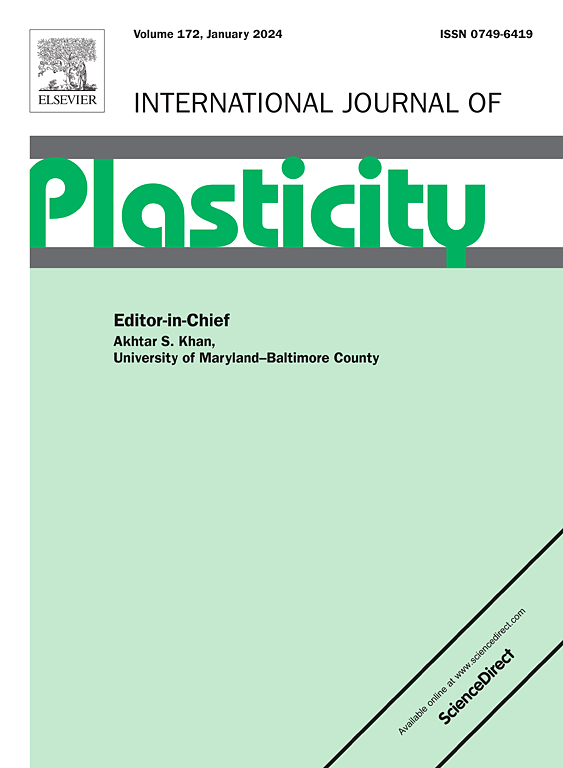具有特定钛含量的富镍高熵合金的变形机制:一种实验和原子方法
IF 12.8
1区 材料科学
Q1 ENGINEERING, MECHANICAL
引用次数: 0
摘要
含钛面心立方(FCC)高熵合金(HEAs)因其优异的力学性能而受到广泛关注。然而,迄今为止,对钛的强化机制和相应的变形行为的研究还很少。本研究揭示了Ti在新型火花等离子体烧结Ni46-xCo18-xAl12Cr8Fe12Mo4-yTi2z (x = 0,y = 0,z = 0;X = 0,1和2,y = 2,z = 1,2和3 at。%) HEA通过实验分析和分子动力学(MD)模拟相结合。烧结体由FCC固溶体组成,存在少量富cr和富mo的脆性sigma (σ)相,FCC基体中存在必需的L12相。屈服强度和抗压强度随Ti含量的增加而不断增加,从无Ti HEA的1130 MPa和1809 MPa增加到6 at的1452 MPa和2011 MPa。% Ti含HEA,同时保持可观的断裂应变>;在所有合并高等教育机构中占26%。这种优异的力学性能主要归因于ti诱导的晶格畸变固有的固溶体强化,以及窄孪晶界、细晶粒尺寸和L12相析出强化的协同效应。MD模拟表明,Ti含量的增加降低了HEAs的层错能,促进了变形孪晶(dt)和层错(sf)的形成。在顺序应变水平下对变形显微组织的表征表明,无Ti HEA中的塑性变形主要是由普通位错滑移介导的,而随着Ti含量的增加,塑性变形主要是通过SF网络和dt的形成以及位错滑动进行的。此外,在加载过程中,高含ti HEAs中动态再结晶分数的增加,归因于晶粒内预先存在的应变的增加,有助于保持令人印象深刻的延展性。本研究对富钛富镍FCC HEAs的变形机理提供了全面的认识,为高性能HEAs的设计提供了指导。本文章由计算机程序翻译,如有差异,请以英文原文为准。


Unravelling the deformation mechanisms in Ni-rich high entropy alloy with tailored Ti content: An experimental and atomistic approach
Ti-containing face centred cubic (FCC) high entropy alloys (HEAs) have garnered significant attention due to their exceptional mechanical properties. Nevertheless, the role of Ti on contributory strengthening mechanisms and the corresponding deformation behavior remains less explored till date. The present study sheds light on evolution of microscale plastic deformation mechanism and the associated strengthening effects induced by Ti addition in a novel spark plasma sintered Ni46-xCo18-xAl12Cr8Fe12Mo4-yTi2z (x = 0, y = 0, z = 0; x = 0, 1 and 2, y = 2, z = 1, 2 and 3 at. %) HEA through a combination of experimental analyses and molecular dynamics (MD) simulations. The sintered compacts were composed of FCC solid solution with presence of minor amounts of brittle Cr-rich and Mo-rich sigma (σ) phases, along with essential L12 phase in the FCC matrix. Yield strength and compressive strength increased continuously with increasing Ti content, from 1130 MPa and 1809 MPa in Ti-free HEA to 1452 MPa and 2011 MPa in 6 at. % Ti containing HEA, respectively, while maintaining an appreciable fracture strain > 26 % in all the consolidated HEAs. Such remarkable mechanical properties are primarily attributed to inherent solid solution strengthening from Ti-induced lattice distortion, along with synergistic effect of narrow twin boundaries, finer grain size and precipitation strengthening from L12 phase. Furthermore, MD simulation revealed that increasing Ti content lowered stacking fault energy of the HEAs and promoted formation of deformation twins (DTs) and stacking faults (SFs). Characterization of deformed microstructures at sequential strain levels showed that plastic deformation in Ti-free HEA was primarily mediated by ordinary dislocation slip, whereas with increase in Ti content, plastic deformation predominantly proceeded through formation of SF networks and DTs, alongside dislocation gliding. Additionally, increased dynamic recrystallization fraction in higher Ti-containing HEAs during loading, attributed to increased pre-existing strain within grains, contributed in retaining impressive ductility. This study provides comprehensive insights into the deformation mechanisms in Ti-added Ni-rich FCC HEAs and offers guidance for designing high-performance HEAs.
求助全文
通过发布文献求助,成功后即可免费获取论文全文。
去求助
来源期刊

International Journal of Plasticity
工程技术-材料科学:综合
CiteScore
15.30
自引率
26.50%
发文量
256
审稿时长
46 days
期刊介绍:
International Journal of Plasticity aims to present original research encompassing all facets of plastic deformation, damage, and fracture behavior in both isotropic and anisotropic solids. This includes exploring the thermodynamics of plasticity and fracture, continuum theory, and macroscopic as well as microscopic phenomena.
Topics of interest span the plastic behavior of single crystals and polycrystalline metals, ceramics, rocks, soils, composites, nanocrystalline and microelectronics materials, shape memory alloys, ferroelectric ceramics, thin films, and polymers. Additionally, the journal covers plasticity aspects of failure and fracture mechanics. Contributions involving significant experimental, numerical, or theoretical advancements that enhance the understanding of the plastic behavior of solids are particularly valued. Papers addressing the modeling of finite nonlinear elastic deformation, bearing similarities to the modeling of plastic deformation, are also welcomed.
 求助内容:
求助内容: 应助结果提醒方式:
应助结果提醒方式:


